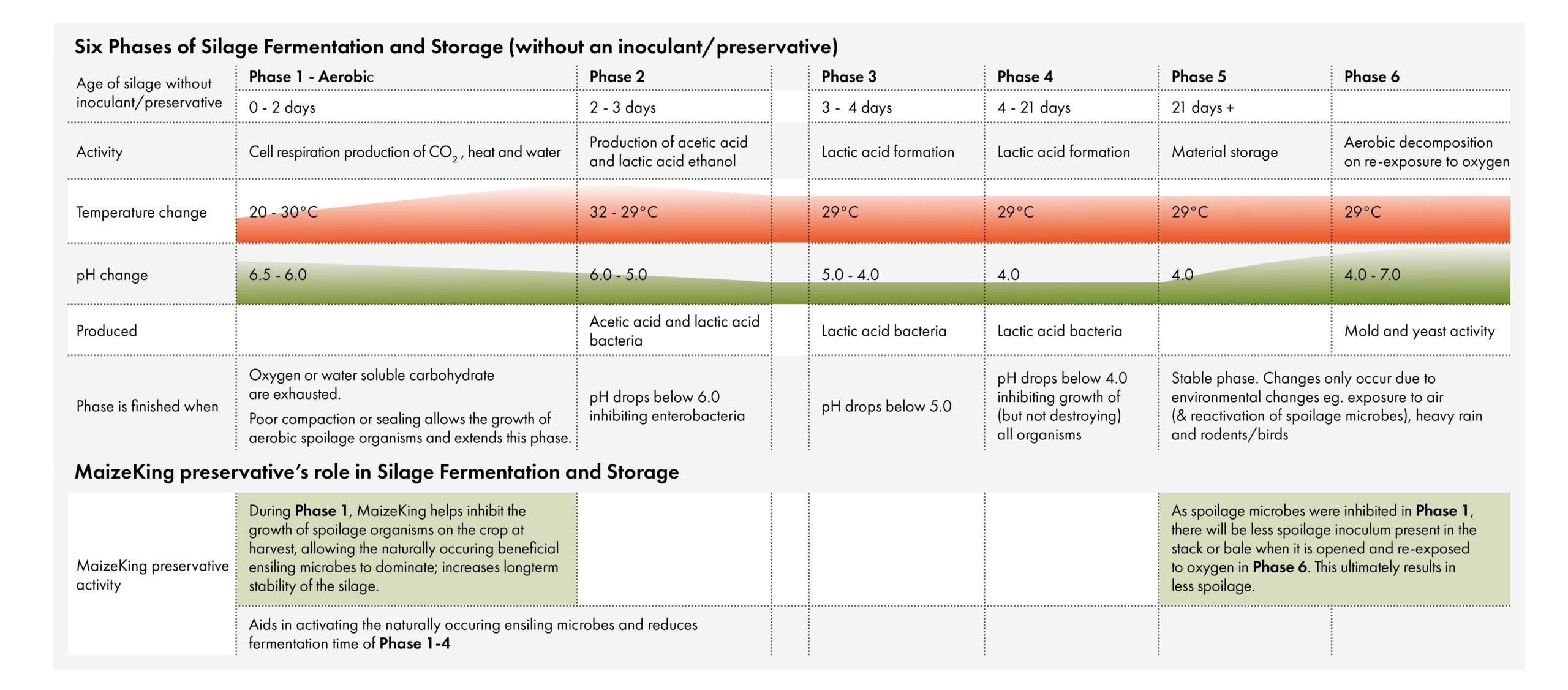Bioguide #11
Silage
Silage: A simple way to preserve surplus spring pasture for feeding animals when feed shortages occur.
The ensiling process relies on the activity of acetic acid and lactic acid-producing bacteria that occur naturally on the forage prior to being cut. During the anaerobic (no oxygen) fermentation process, these bacteria produce both acetic acid and lactic acid bacteria that preserve the forage via a pickling process similar to that used for preserving foods such as sauerkraut and gherkins. If done well this ensiling process preserves the nutritive value that was in the forage for 12–24 months.
To make silage forage is cut and then allowed to wilt to reach an optimum ensiling moisture content (25–35% DM). This partially wilted grass is then harvested and chopped into smaller pieces. The chopped forage is either wrapped tightly into bales (baleage) or put into a silage pit and compressed to remove as much oxygen as possible. The ensiling fermentation occurs in either the bale or the pit over the next 1–6 weeks.
The key to good silage making is to start with a good forage crop (pasture, cereal or lucerne), that is free of animal faeces and has no residual fertilisers left in the paddock. This requires the paddock to be shut up ahead of time and any nitrogen fertiliser applications to be made ahead of time (usually six weeks prior to cutting). Forage should not be cut too low as this will introduce soil and the associated decomposition bacteria into the silage which leads lead to spoilage.
Cutting pasture, cereal or lucerne silage at a Dry Matter percentage of 25–35% is best as it favours a quick fermentation. Chopping the silage to the right length for the DM content will allow best compression and oxygen removal, and will ensure the best ferment.
For maize silage chopping the plants at a DM content of 32–38% is best as this retains the maximum levels of recoverable dry matter in the plant through the ensiling process. Starch can form over 30% of the dry weight of maize silage and is the key source of energy from maize silage.
Key microbes for silage making
The preservation of silage is due to a combination of lactic acid and acetic acid lowering the pH and preserving the silage by inhibiting the activity of spoilage microbes in anaerobic conditions.
Acetic acid bacteria make acetic acid which has a strong anti-spoilage effect on yeast and moulds (fungi). These bacteria are responsible for the initial drop in pH of the silage. The presence of acetic acid helps keep silage cold when a bale or stack is opened and the silage is exposed to oxygen which re-awakens the yeasts and spoilage fungi.
Lactic acid bacteria make lactic acid and some can also make acetic acid. Acetic acid lowers pH and has a preservative effect on silage. Lactic acid bacteria comes in second to carry out the ensiling process and do the majority of preservation.
Other good bacteria are Enterococci such as Enterococcus faecium, that also produce lactic acid.
Six phases of ensiling process
- Phase 1 – aerobic fermentation: Straight after silage is cut and compressed and as much air as possible has been expelled. it is a race between the spoilage and ensiling microbes for nutrients. The pH is neutral to begin with 6–6.5. As microbes ferment the forage they produce CO2 (making it less aerobic), and the fermentation generates heat
- Phase 2 – production of acetic acid, lactic acid and ethanol: The pH drops further 5–6; temperature is ~30ºC. Acetic acid bacteria are beginning to dominate and start lowering the pH, lactic acid-producing bacteria can then start to build their numbers. As oxygen levels lower further and heat increases the growth of spoilage microbe slows.
- Phase 3 – early ensiling: The pH lowers from 5 to 4; lactic acid bacteria are dominating and acetic acid-producing bacteria are receding; growth of spoilage microbes is halted; the silage is largely anaerobic
- Phase 4 – as lactic acid production ramps up and preservation of the forage begins in earnest: Fully anaerobic, the pH is close to 4. This can start within 2–4 days of baling.
- Phase 5 – the silage is anaerobic and at a pH <4 and is stable ready for storage.
- Phase 6 – opening the silage pit or bale: This re-introduces oxygen which wakens the spoilage microbes such as yeast (which produce heat and use up energy to do so) and fungi (some of which can produce mycotoxins that are harmful to livestock).

Silage Spoilage Microbes
Many different moulds and bacteria can spoil silage.
- These microbes are present on the forage when it is cut in the paddock
- These organisms need oxygen to grow (aerobic)
- As silage becomes anaerobic they become “quiescent” (Go to sleep)
- Rapid ensiling ensures minimum growth of spoilage microbes.
These microbes wake up when opening the pit/bale and oxygen returns:
- Enterococci bacteria such as Escherichia coli, Salmonella or Listeria, can enter the silage through animal faeces and these bacteria cause animal health issues
- Clostridial bacteria – Cause animal health issues; produce butyric acid
- Actinomycetes – Soil microbes that enter the stack when forage is cut too low; can speed up spoilage of stack
- Yeast – Grow rapidly when air is available; use up starch when a stack is opened and generate heat
- Moulds – Spoil silage through using up energy and potentially producing mycotoxins harmful to animals e.g. Fusarium, Aspergillus, Penicillium, Cladosporium, Zygomycetes.
Ready to get started?
Check out our range of products dedicated to silage and hay:

